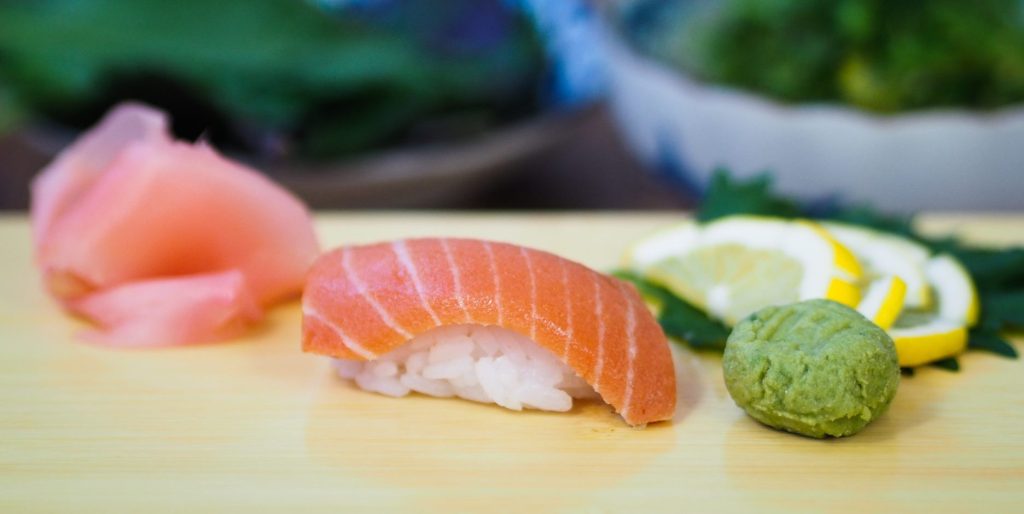Though investment in food technology has slowed in line with the rest of the venture capital world, the industry recently achieved some milestones that suggest the sector and the government are moving into alignment.
In fact, some investors feel that 2023 will be the year when alternative seafood companies and products make notable strides.
More than $178 million was pumped into alternative seafood in the first half of 2022, and the market’s value is poised to reach $1.6 billion over the next 10 years. One of the sector’s biggest investments was Wildtype, which raised $100 million in a Series B round for its “sushi-grade” cultured salmon.
If this momentum held in the past six months, funding into the sector would meet or exceed the $306 million invested in all of 2021, despite the slowdown last year.
“Investment has been growing steadily, and we expect this to continue,” said Christian Lim, managing partner at SWEN Capital Partners’ Blue Ocean. “We see the alternative seafood industry achieving key technical and economic milestones faster than the alternative meat space, which indicates a potential for continued acceleration,” he said.
Many companies say they are in this for the sustainability factor, and even with the initial blessing from the FDA to Upside Foods for its cultivated chicken-making process, the focus is on getting these alternative foods close to the scalability and cost of traditional meat.
“The cultivated seafood industry is beyond needing to solve for the technology — the technology is there and it continues to improve with every iteration,” said Kate Danaher, managing director, S2G Ventures. “Now we need to think about brand-building, labeling, consumer education, scaling production, and developing and improving the supply chain and inputs that will support a scalable industry.”
Like other plant-based, cultured and fermented food companies, alternative seafood companies also must figure out the best way to get people to not only give their products a try but to ask for seconds.
As we kick off 2023, investors say regulation will help alternative seafood make additional strides, and they are optimistic that traction will be found. Read on to find out how active investors are thinking about alternative seafood, where they see growth, what they are keeping their eye on and more.
We spoke with:
- Kate Danaher, managing director, S2G Ventures Oceans and Seafood
- Friederike Grosse-Holz, director, Blue Horizon
- Christian Lim, managing director, SWEN Capital Partners’ Blue Ocean
- Amy Novogratz, co-founder and managing partner, Aqua-Spark
Kate Danaher, managing director, S2G Ventures Oceans and Seafood
What will it take for the alternative seafood industry to have its first unicorn? Do you think 2023 is the year for it? Which companies do you think are close to achieving this milestone?
I do not expect the first alternative seafood unicorn to happen in 2023. The first goal we should all be focused on is demonstration of repeated production runs at viable price points.
Cultivated protein companies have made tremendous progress in the development of their products, but the big hurdle is getting a product of consistent quality and cost to the market.
To date, we have seen big dollars flowing to support the first wave of cultivated protein products, including in seafood. To achieve the step up in valuations that will eventually lead to a unicorn, companies will have to demonstrate a quality product with margins that fit within a viable business model at scale.
There have been some strides in the U.S. toward approving the process for producing alternative protein. How can founders work with regulators and investors to bring more proof-of-concept projects to fruition?
Many constituencies need to be “won over” to mitigate the headwinds that cultivated protein is likely to meet as it goes to market, such as industry groups, consumer groups and regulators.
Startup founders can support industry growth, commercialization and acceptance by building bridges with industry groups to show that cultivated seafood can be complementary to wild and farmed seafood.
Additionally, they should provide transparency into the production process to win over consumer groups and join an association, such as AMPS or Good Food Institute, who are doing important regulatory work on behalf of the industry.
Depending on whom you ask, mainstream production of alternative proteins, like beef, chicken and pork, is still years away. How can the alternative seafood industry achieve this faster?
I feel confident that alternative protein products will be available for purchase in the U.S. in the next 12 months, both cultivated seafood and other animal proteins. But for the foreseeable future, that product will be niche, premium and in limited production. Once production capacity constraints are resolved and costs come down, I expect these products to be as widely available as their animal protein counterparts.
One area where seafood may have an advantage in speed to market is related to regulation, given the FDA has sole jurisdiction over alternative proteins whereas the USDA and FDA share jurisdiction over animal protein.
In addition, seafood has a higher price point and its muscle structure is simpler in comparison to other animal proteins, making it more straightforward to grow a product that more easily replicates wild/farmed species.
Many alternative seafood startups aim to solve for the climate crisis as well, but this industry has unique challenges such as cost and appealing to consumers. What will be key in helping companies produce sustainable products at scale?
For cultivated seafood, the technology is there and it continues to improve with every iteration. Now we need to think about brand building, labeling, consumer education, scaling production, and developing and improving the supply chain and inputs that will support a scalable industry.
If these products can be more affordable and meet consumer expectations, they can achieve impact at scale — for the animal through less wild fishing, for humans by delivering a seafood product with no toxins or microplastics and for the environment through less waste.
Additionally, consumer education will be key. This, in part, includes driving awareness around the true cost of our food beyond what we pay in the grocery store. Consumers are becoming more aware of the externalities and factoring that into their purchasing decisions, but there is much more work to be done in that respect.
What does the future look like for investment in this space? Which areas are you highlighting as future growth indicators?
The good news is that cellular seafood products have reached a stage where they are approaching readiness to go to market from a regulatory, taste and performance perspective.
Cellular seafood companies are making amazing advancements in reducing the price and nearing the stage where they are ready for growth capital to scale the business. I expect to see more innovation and investment into the advancement of consumer experience and 3D structures.
What is needed to attract more institutional investment for later-stage funding to help scale the market?
I fully expect cellular seafood companies to be in a sold-out position in the future, because there is demand from a large early-adopter consumer segment. The next wave of investments will be into infrastructure and companies that build adjacent inputs to outsource parts of the supply chain.
We have strong indications that FDA clearance is coming, and that will tick a big box for institutional and later-stage investors. Once this is behind us, it will be about who is in the market showing traction and producing a product at a price point that makes a compelling business case.
Friederike Grosse-Holz, director, Blue Horizon
What will it take for the alternative seafood industry to have its first unicorn? Do you think 2023 is the year for it? Which companies do you think are close to achieving this milestone?
It will take a clean label and healthy nutritional composition equivalent to seafood, including protein and omega-3 fatty acids.
We recently surveyed 3,700 consumers with Blue Horizon and BCG, asking what it would take for them to consume more alternative proteins, including seafood. It quickly became obvious that consumers are more health conscious than ever since the COVID pandemic. While taste, texture and price remain key purchasing criteria, the health aspect is what drives consumers toward the category.
There have been some strides in the U.S. toward approving the process for producing alternative protein. How can founders work with regulators and investors to bring more proof-of-concept projects to fruition?
There is no “silver bullet” here. Each startup journey is vastly different, but one pattern we have seen working is an iterative approach to go-to-market strategy, product development and regulatory approach. Treat these three elements as one big multiparameter optimization challenge, instead of approaching them sequentially.
Understand the market well enough to estimate the maximum acceptable price of your product, tailor the production process so it offers a clear line of sight into that price and intersect both with the regulatory requirements. And if one of these elements breaks your plan, iterate on all three instead of locking one in. Start these iterations as early as possible, when the team is still small, so agile ways of working are easier to implement and when “mistakes” are still less costly.
Depending on whom you ask, mainstream production of alternative proteins like beef, chicken and pork is still years away. How can the alternative seafood industry achieve this faster?
Food will always be a more capital-intensive industry, so innovations will be harder to scale rapidly than in “classical” VC markets like software.
Partnering with incumbents could be one way to speed up the tedious journey from test kitchens to supermarket shelves — leveraging the expertise and assets of people and organizations that have run manufacturing and distribution in the food space for decades.
Partnerships can be especially helpful in the ingredients space, where sales cycles are long and off-takers are often wary of “newbies.”
Many alternative seafood startups aim to solve for the climate crisis as well, but this industry has unique challenges such as cost and appealing to consumers. What will be key in helping companies produce sustainable products at scale?
An early understanding of how and why your product will make a contribution is key to achieving sustainability at scale. We work closely with portfolio companies to help them articulate and quantify their (envisaged) sustainability parameters — an exercise that many find incredibly helpful.
Quantification, even if it is still high-level at early stages, can help bring out the major factors and show how product development needs to be managed to achieve sustainability at scale. It also helps companies communicate their impact and build a stronger proposition to customers, regulators and investors.
Christian Lim, managing partner, SWEN Capital Partners’ Blue Ocean
What will it take for the alternative seafood industry to have its first unicorn? Do you think 2023 is the year for it? Which companies do you think are close to achieving this milestone?
Achieving price parity, demonstrating production of a delicious product at industrial scale, and having the regulation in place for alternative seafood in large markets such as the U.S. and China will be key to having our first unicorns.
The recent FDA approval of Upside Foods was a significant milestone and a powerful market signal. It may be a bit early to see the first unicorn in the alternative seafood space this year, but we are not so far away.
There have been some strides in the U.S. toward approving the process for producing alternative protein. How can founders work with regulators and investors to bring more proof-of-concept projects to fruition?
Transparency and documenting the sustainability benefits are key.
Depending on whom you ask, mainstream production of alternative proteins like beef, chicken and pork is still years away. How can the alternative seafood industry achieve this faster?
Learn from the meat industry: start with higher-value products (there are more opportunities for this in seafood than in the meat space), anticipate building the value chain (for culture media, for example) and collaborate where possible.
Many alternative seafood startups aim to solve for the climate crisis as well, but this industry has unique challenges such as cost and appealing to consumers. What will be key in helping companies produce sustainable products at scale?
The Life Cycle Analysis of this sector shows the potential for alternative seafood to compete favorably with conventional seafood with regard to carbon emissions. The industry needs to confirm this and deliver as it scales.
What does the future look like for investment in this space? Which areas are you highlighting as future growth indicators?
Investment has been growing steadily, and we expect this to continue. We see the alternative seafood industry achieving key technical and economic milestones faster than the alternative meat space, which indicates a potential for continued acceleration.
Customer surveys also show strong consumer appetite, especially in markets that are open to innovation and have experienced traumatic health and safety issues with conventional seafood.
What is needed to attract more institutional investment for later-stage funding to help scale the market?
Deliver on key milestones: price competitiveness, industrial production of delicious products and regulation in place with first approvals.
Amy Novogratz, co-founder and managing partner, Aqua-Spark
What will it take for the alternative seafood industry to have its first unicorn? Do you think 2023 is the year for it? Which companies do you think are close to achieving this milestone?
I’m confident we will see our first unicorn in blue foods, specifically sustainable aquaculture, in 2023, which will act as a big proof point for investors watching this space.
Most likely, it will be a digital aquatech company helping farmers optimize and automate practices by collecting production data and enabling access to financing and markets. These farm tech companies are beneficial for farmers, fish and the environment, and are starting to really shift the aquaculture supply chain to one that is more sustainable and transparent.
Many alternative seafood startups aim to solve for the climate crisis as well, but this industry has unique challenges such as cost and appealing to consumers. What will be key in helping companies produce sustainable products at scale?
It depends on what part of the industry you are looking at. Digital aquatech solutions are making huge strides in sustainability, with increased efficiencies, less waste, less pollution and better disease management. They also serve the farmer’s bottom line, sometimes even doubling their profits. For me, this scenario is what is so exciting about the sustainable aquaculture opportunity.
In the case of alternative feed ingredients, we are seeing higher price points than traditional feed ingredients because of increased functionality — better growth rates, lower mortality, etc. These ingredients are saving costs elsewhere in the production cycle.
Our whole reason for being is to scale these innovative solutions across the value chain so that truly sustainable aquaculture brings returns that are comparable and even better than today’s commercial industry. We are seeing many proof points that this is working.
What does the future look like for investment in this space? Which areas are you highlighting as future growth indicators?
Alternative feed ingredients (insect, microbes and algae-based) are poised to scale, and the demand is there.
Digital aquatech and data-driven marketplaces continue to be of interest, especially as the data starts to gain value and demand across the supply chain.
What is needed to attract more institutional investment for later-stage funding to help scale the market?
Large-scale proof points of industry adoption and market demand and late-stage startup stories (a unicorn will help).
It’s also going to take a few institutional investors to step up and support the scaling of a new framework that’s solving food security and ocean health challenges. These are two areas that should be on every institutional investor’s radar, as they are directly connected to the viability of this planet.































Comment